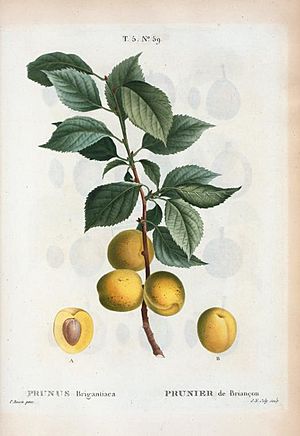Prunus brigantina
Quick facts for kids Prunus brigantina |
|
|---|---|
 |
|
| A drawing of the Briançon apricot tree. | |
| Conservation status | |
| Scientific classification | |
| Genus: |
Prunus
|
| Species: |
brigantina
|
| Synonyms | |
|
|
The Prunus brigantina, also known as the Briançon apricot, is a special wild tree. People also call it the Briançon plum, marmot plum, or Alpine apricot. It grows naturally in the mountains of France and Italy.
Its fruit looks a lot like a regular apricot. However, the Briançon apricot fruit has a smooth skin, unlike the fuzzy skin of common apricots. This tree is quite unique!
Contents
What is the Briançon Apricot?
The Briançon apricot is a type of tree in the Prunus family. This family includes many well-known fruits. Think of cherries, peaches, plums, and regular apricots.
The tree produces small, edible fruits. These fruits are similar in taste to the apricots you might find in a store.
Where Does it Grow?
This tree is native to specific regions. You can find it growing wild in France and Italy. It prefers mountainous areas, which is why it's sometimes called the Alpine apricot.
What is it Used For?
The fruit of the Briançon apricot is edible. People can eat it just like other apricots.
A special oil is made from the seeds of this fruit. It is called 'huile des marmottes' in France. This means 'marmot oil'. This oil has been used for a long time in traditional ways.
Is it an Apricot or a Plum?
Scientists have debated if this tree is truly an apricot or a plum. It's a bit of a mystery!
When scientists look at the plant's chloroplast DNA, it seems more like a plum. Chloroplasts are tiny parts inside plant cells.
But when they study the nuclear DNA, it looks more like an apricot. Nuclear DNA is found in the main part of the cell.
So, Prunus brigantina has features that link it to both groups. This makes it a very interesting plant for scientists to study.
Why is it "Data Deficient"?
The Briançon apricot is listed as "Data Deficient" (DD). This means scientists do not have enough information about it. They need more research to know if it is endangered or not.
It's important to understand how many of these trees exist. We also need to know if their numbers are going up or down. This helps us protect special plants like the Briançon apricot.


